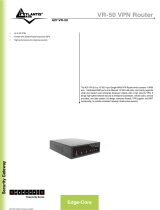
FVL328 Cable/DSL ProSafe High-Speed VPN Firewall
Page 4
19. Why do need a router or firewall when I have a connection to the Internet through my PC already?
With the advent of computer hacking into homes and businesses, the increased reliance on home computers
to store valuable information, and the development of applications that share content over the Internet
through networked PCs, network security becomes an important issue. Simply connecting a PC to a DSL or
cable modem does not provide the necessary security to prevent someone from hacking into a computer.
Having a box that provides firewall or network address translation (NAT) capability provides a simple
solution to this problem.
20. What is network address translation (NAT)?
NAT is used in the router to prevent hacking into the local area network (LAN). NAT substitutes the
“private” IP address of devices located on the LAN side of the router with a new “public” IP address that is
visible on the “Internet side” of the router. By virtue of this simple implementation, any device, up to 253,
located on the LAN will be hidden, or “masqueraded” from Internet hackers trying to get to a specific PC.
Only the router’s IP address is visible on the Internet. This technology provides crude protection against
hackers and is used widely in broadband routers.
21. Is this the same as a firewall?
No. Though the term ”firewall” has been used generically when describing a router’s ability to masquerade
the PC’s IP address, a true firewall employs a technology called Stateful Packet Inspection (SPI). Firewalls
provide a greater level of security, and as a result, are generally more expensive than a NAT router.
Firewalls give the administrator the ability to set up specific IP addresses or domain names that are allowed
to be accessed while refusing the rest (filtering). Firewalls can also allow remote access to the private
network through the use of secure login procedures and authentication certificates (Virtual Private
Networks, or VPNs). Firewalls are used to prevent Denial of Service (DoS) attacks and can use software to
provide content filtering to deny access to unwanted web sites. There are also extensive reporting
capabilities, known as an Intrusion Detection System. The FVL328 and its siblings, the FV318, FR314 and
FR318 are true firewalls.
22. What is Stateful Packet Inspection (SPI)?
SPI is a technology used in firewalls which instead of simply hiding an IP address from the Internet, will
look at each individual packet for information such as its source and destination addresses and the protocol
that is being used, in order to take certain actions based upon a set of pre-established criteria. SPI can be
used to prevent DoS attacks, since the contents within the packet are known.
23. Can I turn off the NAT function on the router and use it just as a firewall behind the router that I already have?
The FVL328 will have this functionality in version 1.1 of the firmware, and will provide the ability to be
used as simply a firewall/VPN device. It will also provide the ability to support static routes in order to set
up subnets for larger scale networks.
24. What are Denial of Service (DoS) attacks?
Packets or requests for service sent from one or multiple PCs that cause disruption of functionality in the
target PC or server. One way to employ a DoS would be to relentlessly “ping” the target server (known as
“Ping of Death”), which requires the target server to respond to the ping. If there were enough pings
requested, the unfortunate server would not be able to respond quickly enough to the pings and at the same
time perform other functions. The result is a denial of service.
25. How does SPI prevent “Ping of Death” or SYN Flood DoS attacks?
The router will look at each packet and if the router notices a specific amount of ping requests over a certain
amount of time coming from the same address, the packets will be dropped. In another example, the router










